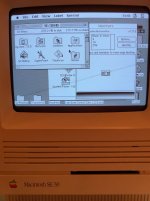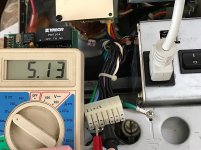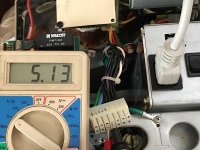I wanted to thank all of you on this thread for the really useful discussion, especially
@superjer2000 for the awesome step-by-step detail and photos!
My problem was a creaky PSU that would power the unadorned SE/30 (albeit with lower-than-rated voltages), but intermittently crash as soon as I added any upgraded kit. Thanks to your advice I picked up the Seasonic SSP-250SUB and installed it in my legacy Apple PSU chassis. The steps I followed were very much in line with
@superjer2000's instructions, but a few details here in case useful for anyone else trying this:
1. Open and gut the Apple PSU. Pound down the standoff sort of sticking up in the middle. Leave the bottom plastic sheet in place.
2. Open the Seasonic PSU. I had to chip away a few dabs of epoxy (?) to disconnect the clips, but then it just unscrews neatly from the base. It's a nice modular PSU with no disassembly required. The Seasonic plug assembly is held in place with three little tabs; it can be pushed right out of the chassis if you manage to squeeze all the tabs at the same time. I did this, removed the Apple plug assembly in the same way, and inserted the Seasonic plug into the Apple chassis. (I left the original Apple switch in place.)
3. Drill appropriately-spaced holes for motherboard standoffs in the Apple chassis and screw the Seasonic PSU guts into place. I left the plastic sheeting the came with the Seasonic PSU in place, but trimmed down the sides down for airflow.
4. The tricky bit, for me, was making the wire harness to connect the Seasonic PSU to the SE/30 analog board. I had trouble using the "staple trick" to get the pins out of the Seasonic harness and also had bad luck with a cheap pin extraction tool I found online. Eventually I ponied up the $20 for this one
https://smile.amazon.com/gp/product/B00GOIY1NE/ref=oh_aui_detailpage_o03_s00?ie=UTF8&psc=1 and it's amazing how much easier it made things. I bought a 10-pin Molex power connector and just followed the diagram linked earlier in this tread to make my harness, tidying things up with cable ties. I also poked in an extra GND wire and a green wire into the PS-ON pin on the Seasonic, which I threaded back under the PSU board to the original Apple switch.
5. I spliced the PS-ON and extra GND wire to the original wires on one side of the Apple switch, so that turning the switch on shorts PS-ON to GND, enabling soft power on the Seasonic PSU. I insulated the splices with heat shrink. Then I snipped the short green grounding wire off of the discarded Apple plug and soldered it to the grounding ring on the Seasonic plug, screwing the other end back onto the Apple PSU grounding ring nearby.
And that's it! Then I put everything back together and tested it with my meter before putting it back inside my Mac. Voltages looked perfect, much stronger than my old PSU which struggled to pull 4.75V on the +5 rail.
One note - I am trying this without the PSU fan for now. Seasonic specs say the fan doesn't come on below 30% utilization anyway, which I'm pretty sure will always be the case. I also have an upgraded Nanoxia Deep Silence fan in my SE/30 which is rated at higher CFM than the original fan, and am not running any spinning HD (just SCSI2SD). So far the PSU never seems to get more than a little warm.
Close-up showing the wire harness plugged into the Seasonic PSU (which is screwed into the Apple PSU chassis)--the yellow and black wires were slightly too long so just loop around slightly off the bottom edge.
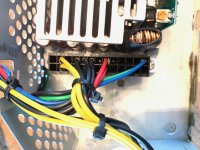
Close-up of the PS-ON and GND wires going to one side of the original Apple switch (spliced + heat shrink):
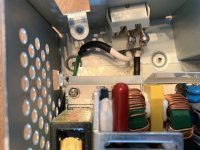
Finished product, visible in this shot is the Seasonic plug assembly with blue capacitors (at right) and small green grounding wire soldered to the grounding tab on the Seasonic plug assembly and screwed into the chassis
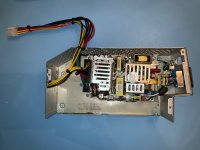
All closed up--looks just like an OEM part from the outside.
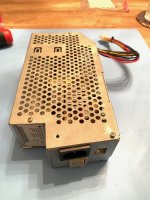
Back home inside my SE/30 and running better than ever!
